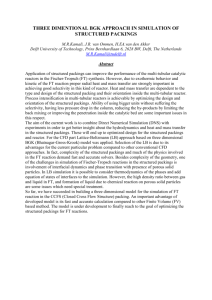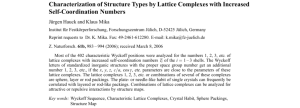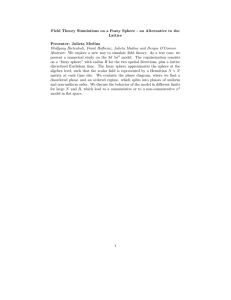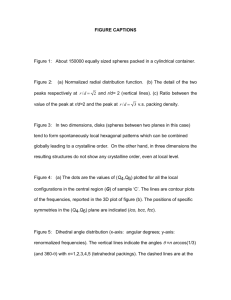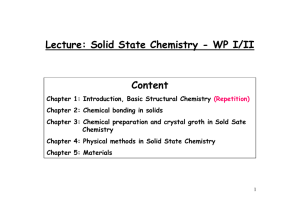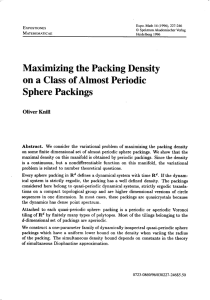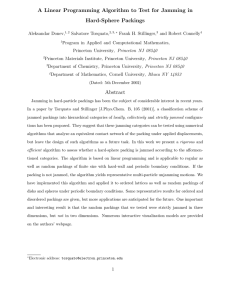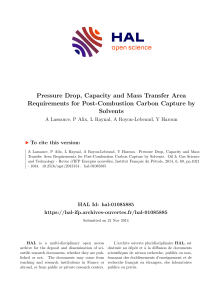Dense Sphere Packings from New Codes
advertisement
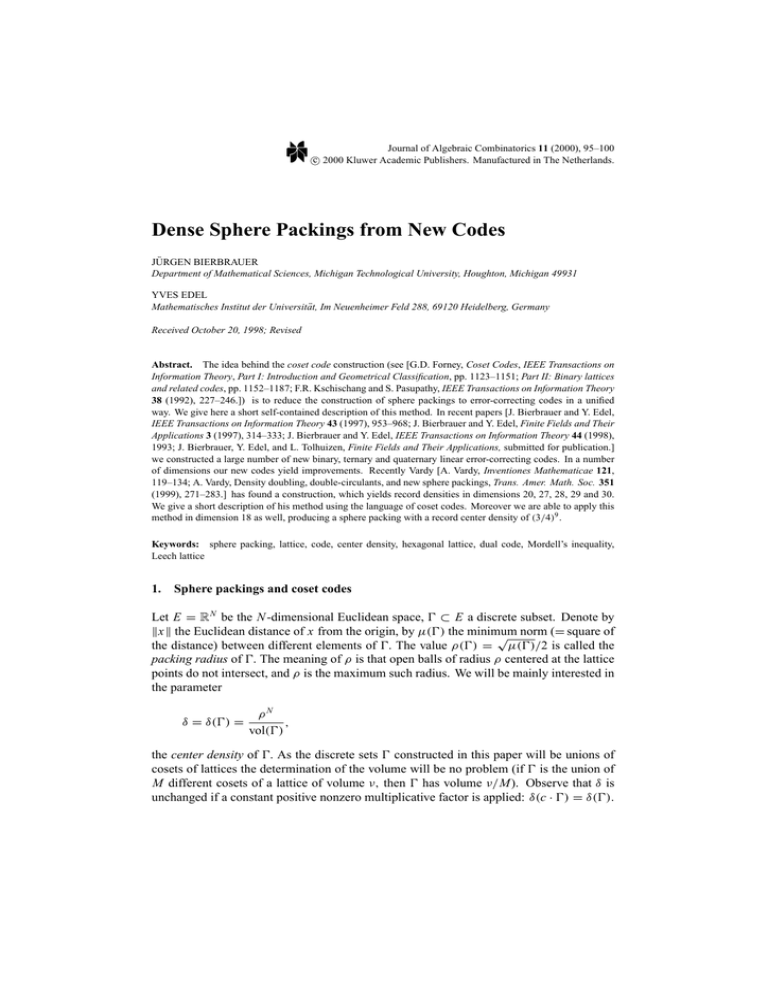
Journal of Algebraic Combinatorics 11 (2000), 95–100
c 2000 Kluwer Academic Publishers. Manufactured in The Netherlands.
°
Dense Sphere Packings from New Codes
JÜRGEN BIERBRAUER
Department of Mathematical Sciences, Michigan Technological University, Houghton, Michigan 49931
YVES EDEL
Mathematisches Institut der Universität, Im Neuenheimer Feld 288, 69120 Heidelberg, Germany
Received October 20, 1998; Revised
Abstract. The idea behind the coset code construction (see [G.D. Forney, Coset Codes, IEEE Transactions on
Information Theory, Part I: Introduction and Geometrical Classification, pp. 1123–1151; Part II: Binary lattices
and related codes, pp. 1152–1187; F.R. Kschischang and S. Pasupathy, IEEE Transactions on Information Theory
38 (1992), 227–246.]) is to reduce the construction of sphere packings to error-correcting codes in a unified
way. We give here a short self-contained description of this method. In recent papers [J. Bierbrauer and Y. Edel,
IEEE Transactions on Information Theory 43 (1997), 953–968; J. Bierbrauer and Y. Edel, Finite Fields and Their
Applications 3 (1997), 314–333; J. Bierbrauer and Y. Edel, IEEE Transactions on Information Theory 44 (1998),
1993; J. Bierbrauer, Y. Edel, and L. Tolhuizen, Finite Fields and Their Applications, submitted for publication.]
we constructed a large number of new binary, ternary and quaternary linear error-correcting codes. In a number
of dimensions our new codes yield improvements. Recently Vardy [A. Vardy, Inventiones Mathematicae 121,
119–134; A. Vardy, Density doubling, double-circulants, and new sphere packings, Trans. Amer. Math. Soc. 351
(1999), 271–283.] has found a construction, which yields record densities in dimensions 20, 27, 28, 29 and 30.
We give a short description of his method using the language of coset codes. Moreover we are able to apply this
method in dimension 18 as well, producing a sphere packing with a record center density of (3/4)9 .
Keywords: sphere packing, lattice, code, center density, hexagonal lattice, dual code, Mordell’s inequality,
Leech lattice
1.
Sphere packings and coset codes
Let E = R N be the N -dimensional Euclidean space, 0 ⊂ E a discrete subset. Denote by
kxk the Euclidean distance of x from the origin, by µ(0) the minimum
√ norm (= square of
the distance) between different elements of 0. The value ρ(0) = µ(0)/2 is called the
packing radius of 0. The meaning of ρ is that open balls of radius ρ centered at the lattice
points do not intersect, and ρ is the maximum such radius. We will be mainly interested in
the parameter
δ = δ(0) =
ρN
,
vol(0)
the center density of 0. As the discrete sets 0 constructed in this paper will be unions of
cosets of lattices the determination of the volume will be no problem (if 0 is the union of
M different cosets of a lattice of volume ν, then 0 has volume ν/M). Observe that δ is
unchanged if a constant positive nonzero multiplicative factor is applied: δ(c · 0) = δ(0).
96
BIERBRAUER AND EDEL
We can therefore assume ρ = 1. Then δ is the reciprocal of the volume of 0. Our objective
is to construct sphere packings with a high center density.
1.1.
Coset codes
Let A0 ⊃ A1 ⊃ · · · ⊃ Al be a chain of m-dimensional lattices, where the factor group
Ai−1 /Ai is isomorphic to the abelian group Ai of order ai , i = 1, 2, . . . , l. Let further
Ci be an ai -ary code of length n, with Mi elements and minimum distance di . We choose
representatives αi j , j = 1, 2, . . . , ai for the cosets of Ai in Ai−1 . Choose αi1 = 0. Put
Ai = {αi j , j = 1, 2, . . . , ai }. Choose Ai as the alphabet over which the code Ci is defined.
It is convenient and no loss of generality to assume that the all-0 word belongs to Ci . The
N = nm-dimensional packing
0 = 0(A0 ⊃ A1 ⊃ · · · ⊃ Al ; C1 , C2 , . . . , Cl )
is defined as the union of M1 M2 · · · Ml cosets of the sublattice (Al )n . The cosets
are parametrized by l-tuples of codewords (v1 , v2 , . . . , vl ), where vi ∈ Ci . Let vi =
(vi1 , . . . , vin ), where vi j ∈ Ai . Then the coset N (v1 , v2 , . . . , vl ) is defined as
Ã
N (v1 , v2 , . . . , vl ) =
l
X
!n
vi j
i =1
+ (Al )n .
j =1
Observe that N (0, 0, . . . , 0) = (Al )n . It is clear that these cosets are distinct so that
vol(0) =
vol(Al )n
.
M1 · · · Ml
How about the minimal norm? Let x, y ∈ 0, x 6= y. If x √
and y belong to the same coset,
then their difference is in (Al )n . It follows kx − yk ≥ µ(Al ). So assume they are in
different cosets. Let x ∈ N (v1 , v2 , . . . , vl ), y ∈ N (v10 , v20 , . . . , vl0 ) and i minimal such that
that x − y has in di of its n components
vi 6= vi0 . As Ci has minimum distance di it follows
√
an entry in Ai−1 \Ai . It follows kx − yk ≥ di · µ(Ai−1 ).
1.2.
The case m = 1
We have A0 = Z, Ai = q1 · · · qi Z (i = 1, 2, . . . , l), µ(Ai ) = (q1 · · · qi )2 , thus
ª
©
µ(0) ≥ Min d1 , d2 q12 , . . . , dl (q1 · · · ql−1 )2 , (q1 q2 · · · ql )2 .
If we use linear codes [n, ki , di ]qi we obtain
δ(0) ≥
l
1 Y
q ki −n · µ(0)n/2 .
2n i=1 i
DENSE SPHERE PACKINGS FROM NEW CODES
1.3.
97
The case m = 2
√
(as generated by
Let A0 = h(1, 0), ( 12 , 23 )i = ha0 , b0 i be the hexagonal lattice
√
root systems of types A2 and G 2 ). The lattice A0 has volume 23 and minimum norm
1 1
) (with respect to
1. The image A1,0 of A0 under the linear mapping with matrix ( −1
2
basis a0 , b0 ) has index√3 in A0 , is generated by a0 + b0 and −a0 + 2b0 and has minimum
distance ka0 + b0 k = 3. As a0 + b0 and −a0 + 2b0 have the same length and include an
angle of π/3 we see that A1,0 is similar to A0 . Applying the same matrix repeatedly we
get A j,0 = A0 M j , for instance A2,0 = 3hb0 , −a0 + b0 i = 3A0 . Aside of this operation we
also consider sublattices of index 4 obtained by multiplication with the constant 2. This
√
leads to the following Definition: A j,k = 2k A0 M j . It is clear that vol(A j,k ) = 4k 3 j 23
and µ(A j,k ) = 4k 3 j . We apply the coset code construction with Ai = A j (i),k(i) , where
j (i) + k(i) = i and either Ai+1 = A j (i)+1,k(i) or Ai+1 = A j (i),k(i)+1 , of index 3 or 4 in Ai .
We have
¡ 2k(l)−1 j (l)+1/2 ¢n
3
2
vol(0) =
|C1 | · · · |Cl |
and
µ(0) ≥ Min{µ(Al ); di+1 µ(Ai ), i = 0, 1, . . . , l − 1}.
2.
A variant of the coset code-construction
We use the following chain of 1-dimensional lattices: A0 = Z ⊃ A1 = 2Z ⊃ A2 =
4Z ⊃ A3 = 8Z and the following codes: C1 = [n, 1, n] (the repetition code), C3
= C1⊥ = [n, n − 1, 2] and binary codes C2 , C20 of length n, minimum distances ≥d and
≥d 0 , respectively. Observe that C2 , C20 are not required to be linear codes. As alphabets
for our codes we use A1 = {0, 1}, A2 = {0, −2}, A3 = {0, 4}. With this notation we define
0 = 0 ∗ (A0 ⊃ A1 ⊃ A2 ⊃ A3 ; C1 , (C2 , C20 ), C3 ) as the union of the following cosets of
(8Z)n in Zn :
N (0, v2 , v3 ),
N (1, v2 , v3 ),
where v2 ∈ 1 + C2 , v3 ∈ C3 (vectors of even type)
where v2 ∈ C20 , v3 ∈
/ C3 (vectors of odd type).
Here 0 and 1 stand for the vectors of length n with all entries 0 and 1, respectively. It is
clear that the addition of cosets is as follows:
N (0, v2 , v3 ) + N (0, w2 , w3 ) = N (0, v2 + w2 , v3 + w3 + v2 ∩ w2 )
N (0, v2 , v3 ) + N (1, w2 , w3 ) = N (1, v2 + w2 , v3 + w3 + v2 ∩ w2 )
N (1, v2 , v3 ) + N (1, w2 , w3 ) = N (0, v2 + w2 + 1, v3 + w3 + v2 ∪ w2 + 1)
Let us determine the minimum Euclidean distance between different elements of 0.
Assume at first x, y√
are both of even type, x ∈ N (0, v2 , v3 ), y ∈ N (0,
3 ). If v2 6= w2 ,
√w2 , w√
then kx − yk ≥ 2 d. If v2 = w2 , v3 6= w3 , then kx − yk ≥ 2 2 = 32. If finally
98
BIERBRAUER AND EDEL
v2 = w2 , v3 = w3 , then kx − yk ≥ 8. The same arguments apply if x and y are both
of odd type. We just have to replace d by d 0 . Let finally x ∈ N (1, v2 , v3 ) be of odd type
and y ∈ N (0, w2 , w3 ) of even type. All entries of x − y are odd integers. We wish to
impose conditions on C2 , C20 ensuring that for at least
√ the entry of x − y is
√ one coordinate
±3 (mod 8). If this is the case, then kx − yk ≥ n − 1 + 9 = n + 8. Assume to the
contrary all entries of x − y are ±1 (mod 8). Fix a coordinate. Consider the 16 possibilities
of how it may be distributed on the vectors v2 , v3 , w2 , w3 . Eight of these are excluded as they
lead to a difference ±3 (mod 8). Write v2 = 1 + u 2 , where u 2 ∈ C2 . The eight remaining
cases are the following:
u2
v3
w2
w3
N (1, v2 , v3 ) − N (0, w2 , w3 )
1
0
0
0
1−0=1
1
0
1
1
1 − 2 = −1
1
1
0
1
5−4=1
1
1
1
0
5 − (−2) = −1
0
0
0
0
− 1 − 0 = −1
0
0
1
0
− 1 − (−2) = 1
0
1
0
1
3 − 4 = −1
0
1
1
1
3−2=1
Here the entry in the last column is to be taken as an integer mod 8, whereas the entries
in the first four columns are 1 or 0. As an example consider the second row of this table:
as u 2 = 1 (equivalently v2 = 0) and v3 = 0, the entry in N (1, v2 , v3 ) is 1 + 0 + 0 = 1. As
w2 = w3 = 1, the entry in N (0, w2 , w3 ) is −2 + 4 = 2. This explains the last entry 1 − 2 =
−1 (mod 8).
This table shows v3 + w3 = w2 ∩ u 2 (here v + w is the symmetric difference v). Observe
that v3 + w3 has odd weight. We will get the desired contradiction if w2 ∩ u 2 is even,
equivalently if C2 and C20 are orthogonal codes.
Theorem 1 Let C2 , C20 be binary codes of length n and minimum distances d, d 0 , respectively, which are orthogonal to each other. Then the n-dimensional sphere packing
0 = 0 ∗ (Z ⊃ 2Z ⊃ 4Z ⊃ 8Z; [n, 1, n], (C2 , C20 ), [n, n − 1, 2])
√ √ √
√
has minimum Euclidean distance min{2 d, 2 d 0 , 32, n + 8} and volume vol(0) =
22n+1 /{|C2 | + |C20 |}. If C2 = C20 is a self-orthogonal linear code containing the all-1
vector, then 0 is a lattice.
Proof: The statements concerning the minimum Euclidean distance and volume are by
now obvious. 0 is a lattice if and only if the cosets it consists of form a subgroup of
(Z)n /(8Z)n . The last claim follows from the addition rules given earlier.
2
This method yields the densest known packings in dimensions 18, 20, 24, 27, 28, 29, 30.
In each case C2 , C20 are an orthogonal pair of linear codes with the same parameters. These
DENSE SPHERE PACKINGS FROM NEW CODES
99
parameters are
[18, 9, 6], [20, 9, 7], [24, 12, 8], [27, 13, 8], [28, 14, 8], [29, 14, 8], [30, 15, 8].
Only in dimension 24 can we choose C2 = C20 . This is the extended binary Golay code
and we obtain a construction of the famous Leech lattice. All the other packings are nonlattice packings. The orthogonal pair with parameters [20, 9, 7] may be derived from the
extended Golay code G: choose C2 to be the subcode vanishing in the first three coordinates,
projected to the last 20 coordinates, and C20 the subcode vanishing at coordinates 1, 2 and
4, also projected to the last 20 coordinates. The orthogonal pair in dimension 18 can be
chosen as extended quadratic residue codes.
3.
Recursive constructions
The following are relatively straightforward recursive constructions.
Lemma 1 If there are packings of center densities δ N , δ j in dimensions N and j, then
there is an (N + j)-dimensional packing of center density δ1 δ2 .
Proof: Let 01 , 02 be the packings whose existence is assumed above. We can choose the
minimum distance of both packings to be = 2. The (N + j)-dimensional packing 01 ⊕ 02
still has minimum Euclidean distance 2, hence δ(01 ⊕ 02 ) = vol(01 ⊕ 02 )−1 = δ1 δ2 . 2
The following Theorem may be proved along the lines of [5], page 167:
Theorem 2 (Mordell’s inequality) Let 0 ⊂ Rn be an n-dimensional lattice of center
density δ, not less dense than its dual 0 ∗ . Let 0 6= x ∈ 0 ∗ be a vector of minimum norm.
Then hxi⊥ ∩ 0 is an (n − 1)-dimensional lattice of center density ≥ 12 δ (n−2)/n .
4.
Some packings in high dimensions
We note that in a number of dimensions use of new codes constructed by us in [1–4] as ingredients in the coset-codes construction yields packings, which are denser that what can be
derived from known packings via Lemma 1 or Theorem 2. The new codes used in these constructions can be derived from the following codes: [144, 51, 32]2 , [140, 50, 32]2 , [155, 132,
8]2 , [162, 138, 8]2 , [86, 77, 5]3 , [85, 74, 6]3 , [86, 54, 14]3 . Naturally it has to be expected
that more sophisticated constructions will yield improvements in all these cases. Still it is
noteworthy that the coset-code construction in its simplest form is capable of producing
dense packings in low dimensions as well as in rather high dimensions. We conclude with
a couple of examples.
In dimension 110 case m = 2 of the coset-code construction applied to ternary codes
[55, 1, 54]3 , [55, 25, 18]3 , [55, 44, 6]3 , and [55, 54, 2]3 yields density 341.5 . In dimension
170 we can use ternary codes [85, 16, 42]3 , [85, 53, 14]3 , [85, 76, 5]3 and [85, 84, 2]3 and
obtain density 785 /368.5 . In dimension 140 we can apply case m = 1 of the coset-code
100
BIERBRAUER AND EDEL
method. Binary codes [140, 1, 128]2 , [140, 50, 32]2 , [140, 117, 8]2 and [140, 139, 2]2 yield
a packing of density 297 .
References
1. J. Bierbrauer and Y. Edel, “New code parameters from Reed-Solomon subfield codes,” IEEE Transactions on
Information Theory 43 (1997), 953–968.
2. J. Bierbrauer and Y. Edel, “Extending and lengthening BCH-codes,” Finite Fields and Their Applications 3
(1997), 314–333.
3. J. Bierbrauer and Y. Edel, “Inverting construction Y1,” IEEE Transactions on Information Theory 44 (1998),
1993.
4. J. Bierbrauer, Y. Edel, and L. Tolhuizen, “New codes via the lengthening of BCH codes with UEP codes,”
Finite Fields and Their Applications, submitted for publication.
5. J.H. Conway and N.J.A. Sloane, Sphere Packings, Lattices and Groups, Springer 1988, 1993.
6. G.D. Forney, Coset Codes, IEEE Transactions on Information Theory, Part I: Introduction and Geometrical
Classification, pp. 1123–1151; Part II: Binary lattices and related codes, pp. 1152–1187.
7. F.R. Kschischang and S. Pasupathy, “Some ternary and quaternary codes and associated sphere packings,”
IEEE Transactions on Information Theory 38 (1992), 227–246.
8. A. Vardy, “A new sphere packing in 20 dimensions,” Inventiones Mathematicae 121, 119–134.
9. A. Vardy, “Density doubling, double-circulants, and new sphere packings,” Trans. Amer. Math. Soc. 351 (1999),
271–283.

